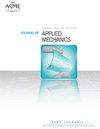A cavity-based micromechanical model for the shear band failure in metallic glasses under arbitrary stress states
IF 2.8
4区 工程技术
Q2 MECHANICS
引用次数: 0
Abstract
Deformation and fracture of metallic glasses are often modeled by stress-based criteria which often incorporate some sorts of pressure dependence. However, detailed mechanisms that are responsible for the shear band formation and the entire damage initiation and evolution process are complex and the origin of such a pressure dependence is obscure. Here we argue that the shear band formation results from the constitutive instability, so that the shear-band angle and arrangements can be easily related to the macroscopic constitutive parameters such as internal friction and dilatancy factor. This is one reason for the observed tension-compression asymmetry in metallic glasses. The free volume coalescence leads to precipitous formation of voids or cavities inside the shear bands, and the intrinsic “ductility” is therefore governed by the growth of these cavities. Based on a generalized Stokes-Hookean analogy, we can derive the critical shear-band failure strain with respect to the applied stress triaxiality, in which the cavity evolution scenarios are sharply different between tension-controlled and shear/compression-dominated conditions. This is another possible reason for the tension-compression asymmetry. It is noted that diffusive-controlled cavity growth could also be the rate-determining process, as suggested by the recent measurements of shear-band diffusivity and viscosity that turn out to satisfy the Stokes-Einstein relationship. This constitutes the third possible reason for the tension-compression asymmetry.基于空腔的任意应力状态下金属玻璃剪切带破坏微观力学模型
金属玻璃的变形和断裂通常采用基于应力的准则来建模,这些准则通常包含一些压力依赖性。然而,导致剪切带形成和整个损伤发生和演化过程的详细机制是复杂的,而且这种压力依赖性的来源尚不清楚。本文认为剪切带的形成是本构失稳的结果,因此剪切带的角度和排列可以很容易地与内摩擦和剪胀系数等宏观本构参数联系起来。这是在金属玻璃中观察到的拉压不对称的一个原因。自由体积聚并导致剪切带内的空洞或空腔的急剧形成,因此这些空腔的生长控制了固有的“延性”。基于广义Stokes-Hookean类比,我们可以推导出相对于应力三轴性的临界剪切带破坏应变,其中在拉伸控制和剪切/压缩主导的条件下,空腔演化情景明显不同。这是拉压不对称的另一个可能原因。值得注意的是,扩散控制的空腔生长也可能是速率决定过程,正如最近对剪切带扩散率和粘度的测量所表明的那样,它们最终满足斯托克斯-爱因斯坦关系。这构成了拉压不对称的第三个可能原因。
本文章由计算机程序翻译,如有差异,请以英文原文为准。
求助全文
约1分钟内获得全文
求助全文
来源期刊
CiteScore
4.80
自引率
3.80%
发文量
95
审稿时长
5.8 months
期刊介绍:
All areas of theoretical and applied mechanics including, but not limited to: Aerodynamics; Aeroelasticity; Biomechanics; Boundary layers; Composite materials; Computational mechanics; Constitutive modeling of materials; Dynamics; Elasticity; Experimental mechanics; Flow and fracture; Heat transport in fluid flows; Hydraulics; Impact; Internal flow; Mechanical properties of materials; Mechanics of shocks; Micromechanics; Nanomechanics; Plasticity; Stress analysis; Structures; Thermodynamics of materials and in flowing fluids; Thermo-mechanics; Turbulence; Vibration; Wave propagation

 求助内容:
求助内容: 应助结果提醒方式:
应助结果提醒方式:


